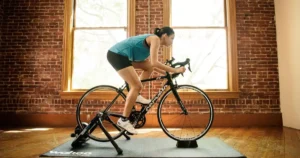Cycling induced pain during urination refers to discomfort or soreness experienced while passing urine, often linked to prolonged bike rides. The pressure exerted on the perineum, a sensitive area between the genitals and anus, may lead to irritation or compression of nerves and blood vessels.
Ever experienced discomfort while cycling and wondered, can cycling cause pain when urinating? If the thought has crossed your mind, you’re not alone. It’s time to take charge of your cycling comfort. Read on to discover simple solutions and expert tips that can make your rides more enjoyable.
This discomfort can be caused by friction, inadequate saddle design, or improper bike setup. If persistent, it is advisable to consult a healthcare professional to address potential issues and find solutions for a more comfortable cycling experience.
Exploring the potential link between cycling and pain during urination
Discovering if there’s a connection between cycling and pain during urination is like unlocking a mystery. We’ll explore the possible reasons behind this discomfort and shed light on how your favourite activity might be linked to this unexpected issue. Join us on a journey to understand the potential link between cycling and the discomfort that can occur when you need to answer nature’s call.
The Perineum’s Role
The perineum is a small but crucial area of our body, located between the genitals and the anus. In the context of cycling discomfort, it plays a significant role, addressing concerns like, can cycling cause pain when urinating? It’s important to understand its role in potential discomforts experienced during or after cycling.
This sensitive region can be affected by pressure and friction during prolonged bike rides, leading to pain during urination, which is why it’s essential to understand how the perineum functions. Making adjustments can help ensure a more comfortable and enjoyable cycling experience, even if you’re considering letting cycling replace leg day.
Why Cycling May Affect Blood Flow to the Perineum
When cycling, the perineum, the area between your genitals and anus, can be affected because of the pressure and compression it experiences on the bike seat. This region contains blood vessels that supply blood to various parts of the body. The pressure from the bike seat may temporarily reduce blood flow to the perineum, causing discomfort.
This reduced blood flow can affect the normal functioning of the nerves and tissues in the area, leading to pain or numbness. Proper bike setup, choosing a suitable saddle, and taking breaks during long rides can help alleviate this vascular impact and make your cycling experience more comfortable.
Culprits of Cycling Discomfort

Saddle sores and friction are common causes of discomfort for cyclists. Saddle sores are irritated areas on the skin, often resulting from prolonged contact with the bike seat. Friction occurs when there’s too much rubbing between your body and the saddle.
These discomforts can lead to pain, especially during and after cycling. Choosing the right saddle, wearing proper cycling shorts, and maintaining good hygiene can help prevent saddle sores and reduce friction, making your cycling experience more enjoyable and pain-free.
The Pressure Points
Cycling can lead to pain during urination due to something called nerve compression in the perineum, the area between your private parts and the back passage. When you ride a bike, especially for long periods, the pressure from the saddle can compress the nerves and blood vessels in this sensitive region.
Think of it like sitting on your hand for too long, it gets tingly and uncomfortable. Similarly, the prolonged pressure on these pressure points during cycling can irritate the nerves and cause discomfort when you pee. Adjusting your bike setup and choosing a proper saddle design can help relieve this pressure and make your rides more comfortable.
Pedaling Towards Comfort
Cycling induced pain during urination can happen due to pressure and friction in the perineal area, the space between the genitals and anus, caused by the bike seat. When cycling, especially for long periods, the saddle can create pressure points, leading to discomfort or pain when urinating.
To pedal towards comfort, consider adjusting your bike setup. Ensure your saddle is well-fitted, and experiment with its angle and height. Padded shorts can also provide extra cushioning, reducing friction. Taking breaks during long rides and maintaining good hygiene can contribute to preventing this discomfort, ensuring a more comfortable cycling experience.
Minimize Pain During and After Cycling
The pressure and friction can lead to irritation, soreness, or even compression of nerves and blood vessels in the perineal region. Long rides can exacerbate these issues. It’s important to address these factors to minimize pain during and after cycling, ensuring a more comfortable and enjoyable riding experience. Adjusting your bike setup and paying attention to saddle design are key steps in preventing or reducing this discomfort.
Bike Setup Matters
Bike setup refers to arranging your bicycle components to ensure a comfortable and efficient riding experience. Finding your comfort zone is crucial because it directly impacts how you feel while cycling. Proper bike setup involves adjusting the saddle height, handlebar position, and pedal alignment to match your body’s proportions.
This not only enhances comfort but also helps prevent issues like pain or discomfort during and after cycling. Taking the time to fine tune your bike setup ensures that your rides are enjoyable and tailored to your individual preferences. So, don’t underestimate the importance of finding your comfort zone for a smoother and more pleasurable cycling experience.
| Key Points | Description |
| Introduction | Unveiling the potential link between cycling and pain during urination. |
| Anatomy Matters | Understanding the vulnerability of the perineum and its role in cycling discomfort. |
| Saddle Sores and Friction | Examining how friction and improper saddle design contribute to pain during urination. |
| Nerve Compression | Investigating the impact of cycling-induced pressure on nerves and blood vessels in the perineal region. |
| Bike Setup Importance | Explaining the significance of proper bike setup in preventing pain during and after cycling. |
| Prevention Strategies | Offering practical tips like choosing the right saddle, maintaining proper posture, taking breaks, and wearing padded shorts. |
| Seeking Professional Advice | Discussing signs indicating when it’s essential to consult a healthcare professional for persistent issues. |
| Conclusion | Summing up key takeaways and encouraging a proactive approach for a pain free cycling experience. |
Tips and Techniques
Preventing pain while cycling involves simple yet effective tips and techniques to enhance your riding comfort. One key aspect is choosing the right saddle, a well fitted, ergonomic seat can significantly reduce pressure on sensitive areas. Maintaining proper bike posture plays a crucial role; adjusting handlebars and seat height helps distribute weight evenly.
Regular breaks during long rides allow your body to relax and prevent prolonged pressure on specific areas. Wearing padded cycling shorts provides an extra layer of protection, reducing friction and potential discomfort. Incorporating tips for pain free cycling enhances your riding experience, making each journey more enjoyable and comfortable.
FAQs
Can cycling lead to pain during urination?
Occasionally, prolonged pressure on the perineum while cycling may cause discomfort, but it’s usually temporary.
What might cause pain while urinating after cycling?
Factors like improper bike setup or a poorly fitting saddle could contribute. Adjustments can often resolve the issue.
Is pain during urination a common cycling issue?
While not common, some riders may experience discomfort. Proper bike setup and breaks during long rides can help prevent this.
Can women experience pain while urinating from cycling?
Yes, women may also face discomfort. Choosing a women’s specific saddle and proper riding attire can alleviate potential issues.
When should one seek medical advice for cycling related urination pain?
If pain persists or worsens, it’s advisable to consult a healthcare professional to rule out any underlying issues and ensure proper cycling ergonomics.
Conclusion
In conclusion, understanding if, can cycling cause pain when urinating? It is crucial for a comfortable riding experience. While occasional discomfort may occur due to pressure on certain areas, it’s often temporary and can be addressed with proper adjustments, like finding the right saddle or taking breaks during long rides. Both men and women may face these challenges, but choosing the right equipment and attire can make a significant difference.
If discomfort persists, seeking advice from a healthcare professional ensures a thorough evaluation of potential issues. Remember, cycling is meant to be an enjoyable and healthy activity, and with the right precautions, any potential discomfort can be minimized. So, keep pedaling, stay mindful of your body’s signals, and make those necessary adjustments for a pain free cycling journey.








